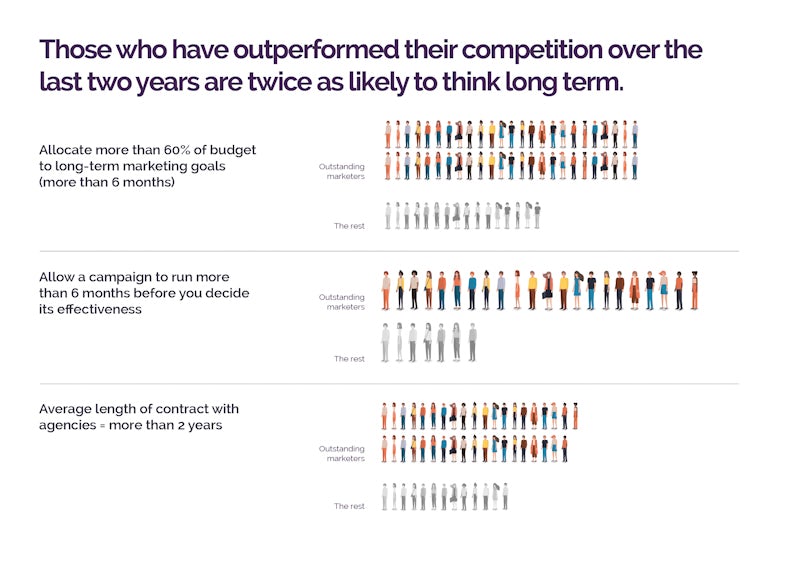The great balancing act: The long and short of B2B marketing
Successful B2B marketers are twice as likely to think long-term, but the pressure to deliver immediate results remains intense. To tackle the growing effectiveness gap, we need to balance the long and the short term.

The case for long-term thinking has been building since Les Binet and Peter Field’s highly influential IPA report, ‘The Long and the Short of It’. They showed that long-term strategies are more effective at moving the dials that really matter – market share, profit, revenue and so on.
Binet and Field’s evidence is largely based on business-to-consumer (B2C) examples. But a new survey of 600 business-to-business (B2B) marketers reinforces the findings. Those who have outperformed their competition over the last two years are twice as likely to think long-term.

The gap between knowing and doing
The business needs quick results. But it takes time to create lasting business impact.
When I talk to senior marketers today, this tension is right at the surface. There’s a curious gap between what we believe and what we can put into action.
Our new research conducted with Marketing Week shows that, in intent at least, the majority of B2B marketers are still ‘classicists’. When asked for the main drivers of effectiveness, audience targeting is comfortably marketers’ highest rated factor, followed by value proposition, then creative. We still believe, then, in the classic skills of segmenting, targeting and positioning.
When asked what marketing performance is judged on, the top answers are profitability, customer retention and closed revenue – solid commercial measures, all. Nobody would argue these are quick fixes. The evidence from Binet and Field and others backs up this view.
Why then, does short-termism seem so widespread?
Only 24% of B2B marketers we spoke to run campaigns for more than six months. Somewhat bizarrely, half of those surveyed measure the results of their campaigns for less time than the business’s average sales cycle.
Depending on how cynical you are, it suggests a big problem or a convenient excuse. We can’t be held accountable if we’re not around long enough to see the results play out.
The measurement problem
Part of the conundrum is the burden of proof.
It takes long-term investments to improve preference and create an easier selling environment. But it’s hard to make an 18-month-plus business case while running like billy-o to hit quarterly revenue targets. And there are so many variables involved in a B2B sale that any attribution model is easy to pick holes in.
Faced with the need to be accountable, it’s easy to retreat to upstream measures like marketing-qualified leads (MQLs). When the pressure is on, we can spend more on content syndication and paid search to create more ‘leads’.
This is partly why conversion rates from MQLs to sales remain low, to the extent that the term MQL has become shorthand for marketing’s lack of commercial end-product. I know of one CEO who has banned the term.
In B2B, sales is a long term game
Binet and Field offer a formula for effectiveness, the now famous 60:40 split – 60% of resources go to long-term brand building, 40% to short-term sales activation.
In B2B, the distinction between brand and sales activation is not as straightforward.
There is a truism currently popular that we all market to humans. But for (most) B2B brands, the context is radically different from B2C. The sales cycle is typically much longer; often six months or more. There are multiple decision-makers (more than six on average and growing, according to CEB research).
Marketing works best when it follows a long-term strategy, but the operating model must be based on short feedback loops.
These are people motivated by business objectives, yes. But they are also powerfully led by personal and political goals. Their careers are on the line. Their jobs and livelihood, their promotion, even their sense of self-worth may be at stake.
Google and CEB research as far back as 2013 suggested that emotion plays a bigger role in B2B decisions than in B2C. More recently, Harvard Business Review made the case that subjective values like ‘reputational assurance’ and even ‘hope’ can improve loyalty and NPS.
Most sales people I know recognise marketing has two uses: to unearth sales opportunities now and to make it easier to sell in the future. These two tasks are present in different levels in every communication. So it’s not just brand that requires a long-term plan; all communications do.
The long and the quick
Our research also hints at something key to balancing the long and short term. When asked why campaigns fail, leading marketers are less likely than the rest to blame others, particularly a lack of buy-in from the business. But they are more likely to cite poorly defined briefs. To blame themselves, in other words.
When you combine it with their preference for longer programmes, we get a sense that the leaders are more reflective. Their mentality is to build, test, adapt – not to cut and run.

This agile mentality is what it means to be a data-driven marketer. Not measurement for its own sake, but the ability to adapt and respond to feedback. Marketing works best when it follows a long-term strategy, but the operating model must be based on short feedback loops.
One of the best B2B marketing leaders I know runs a rolling three-year plan, which helps drive this balance. It has allowed to her to win the trust of the business, transform a function and double her conversion rates.
The B2B marketing leaders who stand out in the future will balance these two factors: the long and the quick.
David van Schaick is CMO of The Marketing Practice.
Look out for Marketing Week’s video series on achieving excellence in B2B marketing, in partnership with The Marketing Practice, coming soon to marketingweek.com. In the meantime, you can read the research in full here.






